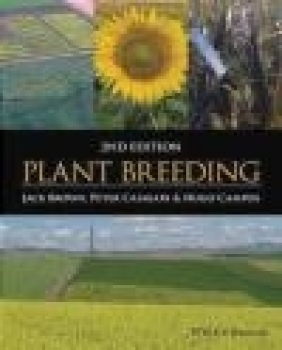Plant Breeding
Hugo Campos, Peter Caligari, Jack Brown
Plant Breeding
Hugo Campos, Peter Caligari, Jack Brown
- Producent: Blackwell Science
- Rok produkcji: 2014
- ISBN: 9780470658307
- Ilość stron: 256
- Oprawa: Miękka
Niedostępna
Opis: Plant Breeding - Hugo Campos, Peter Caligari, Jack Brown
This book, Plant Breeding, has it bases in an earlier text entitled An Introduction to Plant Breeding by Jack Brown and Peter Caligari, first published in 2008. The challenges facing today's plant breeders have never been more overwhelming, yet the prospects to contribute significantly to global food security and farmers' quality of life have never been more exciting and fulfilling. Despite this there has been a worrying decline in public funding for plant breeding-related research and support for international centers of germplasm development and crop improvement. In part, this has resulted in a serious reduction in the number of young people interested in devoting their professional careers to plant breeding as well as the number of universities offering plant breeding courses or conducting relevant research in plant breeding. The authors' aim in writing this book is to provide an integrated and updated view of the current scientific progress related to diverse plant breeding disciplines, within the context of applied breeding programs. This excellent new book will encourage a new generation of students to pursue careers related to plant breeding and will assist a wider audience of agricultural students, agronomists, policy makers and those with an interest in agriculture in gaining insight about the issues affecting plant breeding and its key role in improving the quality of life of people and in securing sufficient food, at the quality required and at an affordable price.
With comprehensive coverage including questions designed for students, and an accompanying website containing additional material to help in the study of the subject, Plant Breeding is an ideal text for all those studying plant and crop sciences, and a convenient reference source for professionals working in the area. All libraries within universities and research establishments where biological and agricultural sciences are studied and taught should have multiple copies of this book.Preface xi
About the companion website xiii
1 Introduction 1
1.1 Requirements of plant breeders 1
1.2 Evolution of crop species 4
1.2.1 Why did hunter-gatherers become farmers? 4
1.2.2 What crops were involved? And when did they arise? 5
1.3 Natural and human selection 8
1.4 Contribution of modern plant breeders 8
Think questions 11
2 Modes of Reproduction and Types of Cultivar 13
2.1 Introduction 13
2.2 Modes of reproduction 15
2.2.1 Sexual reproduction 15
2.2.2 Asexual reproduction 16
2.3 Types of cultivar 17
2.3.1 Pure-line cultivars 17
2.3.2 Open-pollinated cultivars 17
2.3.3 Hybrid cultivars 18
2.3.4 Clonal cultivars 18
2.3.5 Synthetic cultivars 18
2.3.6 Multiline cultivars 18
2.3.7 Composite-cross cultivars 19
2.4 Annuals and perennials 19
2.5 Reproductive sterility 19
Think questions 19
3 Breeding Objectives 21
3.1 Introduction 21
3.2 People, politics and economic criteria 22
3.3 Grower profitability 25
3.3.1 Increasing harvestable yield 26
3.3.2 Selection for yield increase 27
3.4 Increasing end-use quality 28
3.4.1 Testing for end-use quality 30
3.5 Increasing pest and disease resistance 31
3.6 Types of plant resistance 34
3.7 Mechanisms for disease resistance 35
3.8 Testing plant resistance 36
3.9 Conclusions 38
Think questions 38
4 Breeding Schemes 40
4.1 Introduction 40
4.2 Development of pure-line cultivars 40
4.2.1 Homozygosity 41
4.2.2 Breeding schemes for pure-line cultivars 43
4.2.3 Number of segregating families and selections 46
4.2.4 Seed increases for cultivar release 46
4.3 Developing multiline cultivars 47
4.3.1 Backcrossing 48
4.4 Development of open-pollinated population cultivars 49
4.4.1 Breeding schemes for open-pollinating population cultivars 49
4.4.2 Backcrossing in open-pollinated population cultivar development 51
4.5 Developing synthetic cultivars 51
4.5.1 Seed production of a synthetic cultivar 53
4.6 Developing hybrid cultivars 53
4.6.1 Heterosis 55
4.6.2 Types of hybrid 58
4.6.3 Breeding system for F1 hybrid cultivars 58
4.6.4 Backcrossing in hybrid cultivar development 59
4.6.5 Hybrid seed production and cultivar release 60
4.7 Development of clonal cultivars 61
4.7.1 Outline of a potato breeding scheme 61
4.7.2 Time to develop clonal cultivars 62
4.7.3 Sexual reproduction in clonal crops 63
4.7.4 Maintaining disease-free parental lines and breeding selections 64
4.7.5 Seed increase of clonal cultivars 64
4.8 Developing apomictic cultivars 64
4.9 Summary 65
Think questions 65
5 Genetics and Plant Breeding 68
5.1 Introduction 68
5.2 Qualitative genetics 68
5.2.1 Genotype/phenotype relationships 70
5.2.2 Segregation of qualitative genes in diploid species 70
5.2.3 Qualitative loci linkage 72
5.2.4 Pleiotropy 76
5.2.5 Epistasis 76
5.2.6 Qualitative inheritance in tetraploid species 77
5.2.7 The chi-square test 79
5.2.8 Family size necessary in qualitative genetic studies 81
5.3 Quantitative genetics 82
5.3.1 The basis of continuous variation 82
5.3.2 Describing continuous variation 83
5.3.3 Relating quantitative genetics and the normal distribution 86
5.3.4 Quantitative genetics models 87
5.3.5 Testing the models 90
5.3.6 Quantitative trait loci 97
Think questions 101
6 Predictions 104
6.1 Introduction 104
6.1.1 Genotype × environment interactions 104
6.1.2 Genetically based predictions 105
6.2 Heritability 106
6.2.1 Broad-sense heritability 107
6.2.2 Narrow-sense heritability 108
6.2.3 Heritability from offspring parent regression 109
6.3 Diallel crossing designs 110
6.3.1 Griffing s analysis 111
6.3.2 Hayman and Jinks analysis 116
6.4 Cross prediction 119
Think questions 120
7 Selection 125
7.1 Introduction 125
7.2 What to select and when to select 125
7.2.1 Qualitative trait selection 126
7.2.2 Quantitative trait selection 126
7.2.3 Positive and negative selection 126
7.3 Response to selection 127
7.3.1 Association between traits or years 129
7.3.2 Heritability and its limitations 130
7.3.3 Methods of selection 131
7.3.4 Errors in selection 133
7.4 Applied selection 136
7.4.1 Number of genotypes in initial populations 136
7.4.2 Early generation selection 139
7.4.3 Intermediate generation selection 141
7.4.4 Advanced generation selection 143
7.4.5 Analysis of location trials 146
7.5 Cross prediction 151
7.5.1 Univariate cross prediction 152
7.5.2 Multivariate cross prediction 157
7.6 Parental selection 159
7.6.1 Phenotypic evaluation 160
7.6.2 Genotypic evaluation 160
7.6.3 Parental combinations 161
7.6.4 Germplasm collections 162
Think questions 163
8 Broadening the Genetic Basis 168
8.1 Induced mutations 168
8.1.1 Methods of increasing the frequency of mutation 169
8.1.2 Types of mutation 169
8.1.3 Plant parts to be treated 170
8.1.4 Dose rates 170
8.1.5 Dangers of using mutagens 171
8.1.6 Impact of mutation breeding 171
8.1.7 Practical applications 172
8.2 Interspecific and intergeneric hybridization 174
8.2.1 Characters introduced to crops from wild related species 174
8.2.2 Factors involved in interspecific or intergeneric hybridization 175
8.2.3 Post-fertilization 176
8.2.4 Hybrid sterility 176
8.2.5 Backcrossing 176
8.2.6 Increasing genetic diversity 177
8.2.7 Creating new species 177
8.3 Plant genetic transformation 177
8.3.1 A glimpse at the genetic transformation of plants 179
8.3.2 Some applications of genetic engineering to plant breeding 181
8.3.3 Cautions and related issues 183
Think questions 183
9 Contemporary Approaches in Plant Breeding 185
9.1 Introduction 185
9.2 Tissue culture 185
9.2.1 Doubled haploids 185
9.2.2 Some potential issues 186
9.2.3 In vitro multiplication 188
9.3 Molecular markers in plant breeding 188
9.3.1 Theory of using markers 188
9.3.2 Types of marker systems 190
9.3.3 Molecular markers 191
9.3.4 Uses of molecular markers in breeding programmes 192
9.3.5 Issues with markers 195
9.3.6 The increasing availability of genome sequences 195
Think questions 197
10 Practical Considerations 198
10.1 Introduction 198
10.2 Experimental design 198
10.2.1 Unreplicated designs 199
10.2.2 Randomized designs 201
10.2.3 The increasing role of linear mixed model approaches to analyse breeding data 203
10.3 Greenhouse management 204
10.3.1 Artificial hybridization 204
10.3.2 Seed and generation increases 206
10.3.3 Evaluation of breeding lines 206
10.3.4 Environmental control 207
10.3.5 Disease control 207
10.3.6 Economics 208
10.3.7 Experimental design in the glasshouse 209
10.4 Field plot techniques 209
10.4.1 Choice of land 209
10.4.2 Plot size and replication 211
10.4.3 Guard rows and discard rows 212
10.4.4 Machinery 212
10.5 Use of computers in plant breeding 214
10.5.1 Data storage and retrieval 215
10.5.2 Field plan design 217
10.5.3 Clerical operations 217
10.5.4 Data collection 217
10.5.5 Data analysis 218
10.5.6 Selection 219
10.5.7 Data transfer 220
10.5.8 Statistical consultation 220
10.5.9 Ease of use 220
10.6 Release of new cultivars 220
10.6.1 Information needed prior to cultivar release 221
10.6.2 Value in release 221
10.6.3 Cultivar names 222
Think questions 222
11 Current Developments in Plant Breeding 223
11.1 Intellectual property and ownership issues 223
11.1.1 Patents 223
11.2 The impact of biotechnology 225
11.3 The regulation of genetically modified plants 227
11.4 Plant breeding as a career 228
Further Reading 229
Suggested Answers to Think Questions 230
Index 271
Szczegóły: Plant Breeding - Hugo Campos, Peter Caligari, Jack Brown
Tytuł: Plant Breeding
Autor: Hugo Campos, Peter Caligari, Jack Brown
Producent: Blackwell Science
ISBN: 9780470658307
Rok produkcji: 2014
Ilość stron: 256
Oprawa: Miękka
Waga: 0.52 kg






























